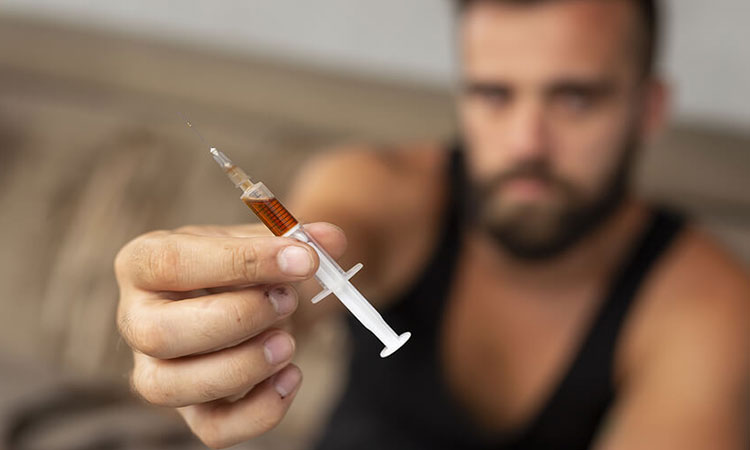
Heroin and fentanyl are both opioid drugs that attach to opioid receptors in the brain, thereby reducing sensations of pain and inducing elevating feelings of pleasure and relaxation. Both are extremely powerful, fast-acting, and can be deadly in just one dose.
Heroin vs. Fentanyl: The Basics
Heroin is derived from morphine, a natural alkaloid that is found in the seed of the opium poppy. Heroin is commonly distributed as a white, tan, or brown powder, or sometimes as a black, tacky substance, aptly referred to as “black tar” heroin.
The Drug Enforcement Administration has classified heroin as a Schedule I controlled substance with no accepted medical use. Heroin can be smoked, snorted, or injected.
Fentanyl is a synthetic opioid similar in effect to both morphine and heroin. However, it is also approximately 50 times more potent than heroin and as much as 100 times more powerful than morphine. The chemical structure of fentanyl is somewhat different from that of heroin.
Fentanyl was first synthesized in 1960 as an extremely effective painkiller. It is still widely used medically to treat severe pain related to injuries or surgery or for chronic pain among those who don’t respond to less powerful opioids. So unlike heroin, fentanyl does have some accepted medicinal use and is therefore classified by the DEA as a Schedule II controlled substance.
Fentanyl can be diverted from legitimate uses for abuse, and it is also manufactured illegally in clandestine laboratories, particularly China. Fentanyl is less expensive and easier to obtain than heroin and is often included as a cutting agent in heroin.
Fentanyl exposure is extremely dangerous, as it can be absorbed through the skin and as little as .25 milligrams can be lethal. Prescription fentanyl can be found in lozenges, sublingual tablets, nasal and oral sprays, as an injectable, and as a transdermal patch.
Also, illicit fentanyl can be made into pills to look like other prescription opioids such as Norco, or be manufactured in powder form. Such is the case involving the death of the artist Prince, who died from a fentanyl overdose after consuming illicit pills labeled as Vicodin.
Overdose and Side Effects

Overdose deaths involving heroin or fentanyl have been increasing each year steadily since the turn of the century. In 1999, there were less than 2,000 deaths in the U.S. involving heroin.
By 2017, that number had risen to more than 15,000, according to the Centers for Disease Control and Prevention. Also, among the more than 70,200 drug overdose fatalities in 2017, the most significant increase took place among deaths related to fentanyl and fentanyl analogs with more than 28,400 overdose fatalities.
LINK: https://www.drugabuse.gov/related-topics/trends-statistics/overdose-death-rates
Many of these deaths may be because persons exposed to fentanyl may not realize that it is present in the drug they are taking. It’s often laced into or passed off as pure heroin or other drugs to maximize dealer profits. However, fentanyl is more potent than heroin and can result in a toxic buildup, meaning it can precipitate an overdose faster and in smaller doses.
An opioid overdose becomes life-threatening when the user’s breathing becomes profoundly depressed. Heart rate is also reduced, body temperature decreases, and people may become confused, drowsy, lethargic, or fall completely unconscious, unable to be awakened.
An overdose on either fentanyl or heroin has the potential to cause death. Overdoses on both drugs can be reversed with the prompt administration of the opioid antagonist Narcan (naloxone). Because fentanyl is more potent in lower doses than heroin, it may take multiple doses of naloxone to reverse the toxic effects.
Both heroin and fentanyl abuse can result in permanent damage to the respiratory and cardiovascular system, as well as brain damage and cognitive impairments. Injecting either of these drugs also increases the risk of collapsed veins, track marks, and skin abscesses, and of contracting an infectious disease, such as hepatitis and HIV/AIDS.
Tolerance, Dependence, and Addiction
Both fentanyl and heroin have an extremely high potential for addiction. These two drugs can induce intense and euphoric feelings, and physiological dependence can develop rapidly. When the brain becomes accustomed to the presence of an opioid, the body will require the drug to function normally.
For users who have become dependent on one of these drugs, unpleasant withdrawal symptoms onset when the drug effects wear off. These withdrawals may include depression, anxiety, irritability, insomnia, and flu-like symptoms. For many, it may seem better to keep using the drug than to cope with these nasty withdrawal symptoms, and this behavior can quickly result in an inability to control drug use.
Also, frequent drug use over time leads to the development of tolerance, a condition in which the person using requires increasing amounts of the drug in order to achieve the desired effect. Simply put, drug addiction can be defined as compulsive drug consumption driven by altered brain chemistry as a result of routine drug abuse.

Heroin vs. Fentanyl Comparison
Heroin
- Semi-synthetic opioid
- Highly addictive
- Illicit drug with no accepted medical use
- Manufactured in powder form
- Smoked, snorted or injected when abused
- Fast-acting and induces a short but intense rush
- Potential for rapid onset of overdose, resulting in life-threatening respiratory depression
- Often requires medical detox and opioid replacement therapy to clear the drug from the body safely, and prevent withdrawal symptoms and relapse
- Often requires comprehensive treatment for long-lasting recovery
Fentanyl
- Synthetic opioid
- Highly addictive
- Available by prescription in several forms as a potent painkiller and also manufactured illicitly
- Manufactured as a pill, tablet, lozenge, patch, an injectable liquid, or powder
- Ingested, smoked, snorted or injected when abused
- Fast-acting and induces a brief but intense rush
- Lethal in microgram doses and can be absorbed through the skin by accidental contact
- Often requires medical detox and opioid replacement therapy to safely clear the drug from the body and prevent withdrawal symptoms and relapse
- Often requires comprehensive treatment for long-lasting recovery
Getting Help for Opioid Addiction
Both heroin and fentanyl are dangerous and potent opioids, and comprehensive substance abuse treatment is usually necessary to address addiction to these substances. Several pharmaceuticals are FDA-approved to treat opioid dependence such as buprenorphine and naltrexone, and the use of these combined with behavioral therapies are often useful in managing cravings and withdrawal symptoms associated with former opioid use.
Because both heroin and fentanyl are both short-acting opioids, they can be replaced with a longer-acting opioid during medical detox and addiction treatment. Neither should ever be discontinued cold turkey. An opioid withdrawal medication is often administered and then slowly tapered off to mitigate withdrawal symptoms and cravings.
Addiction to opioids is a dangerous and potentially life-threatening condition that should be comprehensively treated as a chronic disease. Midwood Addiction Treatment offers an integrated, evidence-based approach to addiction treatment that features behavioral therapy, individual and family counseling, group support, and more.
Our center employs caring addiction specialists who render these services to clients with compassion and expertise. We are dedicated to the safe recovery of every client and provide them with the tools they so urgently need to achieve a full recovery and experience long-term sobriety and well-being indefinitely.
Recovering from addiction is a life-long process, but you don’t have to do it alone. Contact us today and find out how we can help you reclaim the life you deserve!